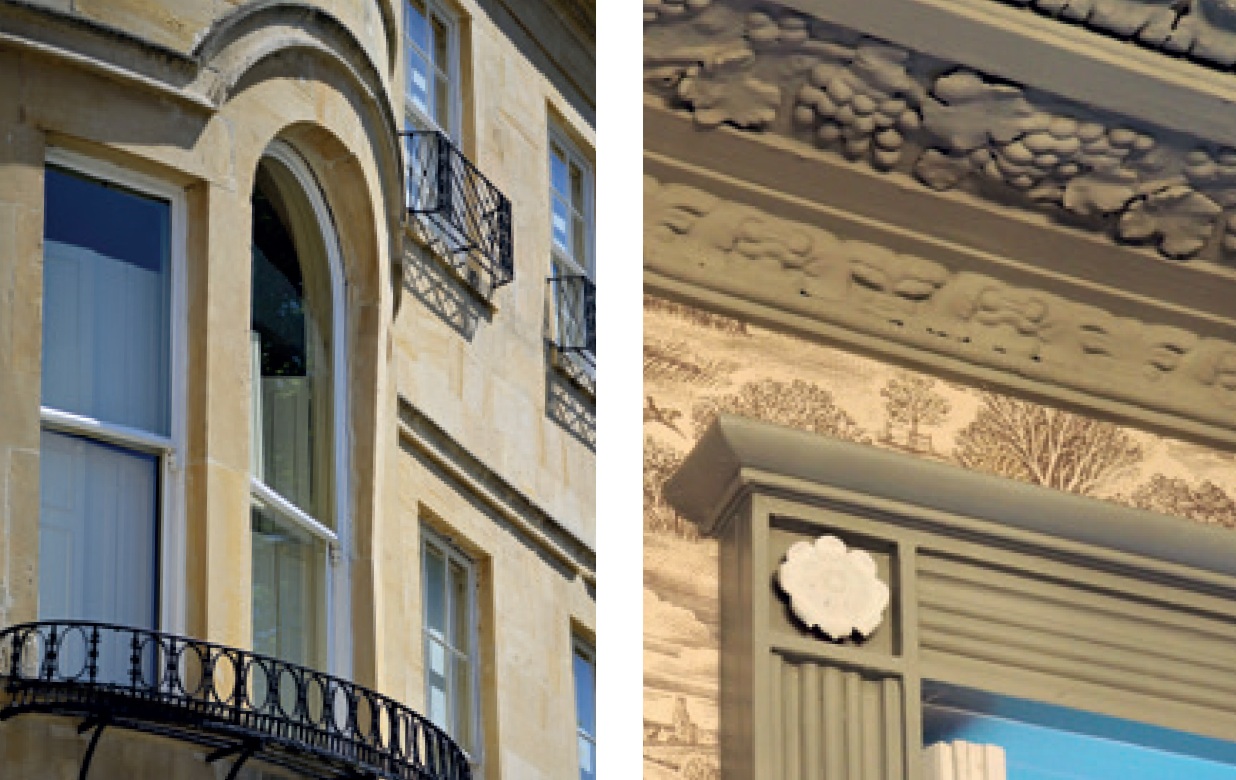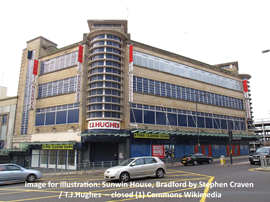Sustainable heating for listed buildings
The problem of how to reduce the approximately 17 per cent of the UK’s carbon emissions produced by space heating and cooling of buildings needs to be approached intelligently.

|
| Adding insulation to the external walls of a listed building is rarely simple and risks trapping moisture. |
Contents |
Introduction
It is now generally accepted that most traditionally constructed buildings are unsuited to the high levels of insulation required to meet current building regulations. Some improvements are clearly practical and necessary in the vast majority of cases, with minimal harm to their character and significance, but many listed buildings will have to look at other avenues for reducing their carbon emissions if these buildings are to play their part in achieving a reduction of 43 per cent by 2030 and net zero by 2050. These can include low- and zero-carbon heating technology and better management of heat. Insulation is not the only solution.
The problem with insulation
The best place for insulation is on the outside of a structure. Placed here heat from the inside keeps the fabric warm in winter, minimising the chance of condensation and promoting faster drying should any moisture find its way into the structure. Failing to get this right can lead to mould growth, decay and loss of the original material’s insulation value due to the higher thermal conductivity of a damp structure. Placed on the outside, the insulation also protects the walls from external heat so they remain cooler in the summer, and their mass helps to moderate temperature fluctuations. The downside is that external insulation changes the appearance of historic buildings dramatically by obscuring surface textures and details and by changing the size and proportion of features like window openings and eaves. Major alterations may also be required to the roof, eaves and windowsill details to protect external insulation from the rain.
On buildings which are important historically or aesthetically, insulation is more usually applied to the interior face of external walls and inside the roof space. Here perhaps the biggest drawback is that it makes everything on the outer side colder and more prone to condensation, including roof and wall structures, for example, so the insulation needs to be highly permeable. It is also less efficient, as cold bridging will occur wherever cross walls connect with the outer wall through the insulation.
Research published by Historic England in 2020 (Understanding Carbon in the Historic Environment) showed that a sensitively retrofitted Victorian terrace home might not be able to compete with a new-build equivalent if only the day-to-day carbon cost of heating were taken into consideration. However, when the carbon expended in all aspects of their current retrofit and construction were included, the retrofit outperformed the new build for almost 60 years. In other words, it took almost 60 years for the lower day-to-day carbon running costs of the new-build to off-set its initial carbon costs.
The Victorian terraced building is a relatively straightforward case which provides a model for a high proportion of historic buildings, including unlisted buildings in conservation areas. However, it would be wrong to conclude that all listed buildings could be subjected to the same level of alteration, particularly where fine interiors would be irreversibly altered. For many a balanced approach will be necessary, taking the easy wins first, like draught-stripping windows and doors, and increasing insulation in the roofs within safe parameters, without the risk of interstitial condensation. The rest must come mainly from reducing carbon in heating.
Electric heating and heatpumps
According to the National Grid, over 40 per cent of the UK’s electricity is currently generated by renewables annually, including wind power in particular, and the proportion is set to rise further. An additional 15 per cent is currently generated by nuclear power. Gas and nuclear power stations will continue to be part of the mix as energy from solar and wind farms varies with the weather. However, currently no power stations in the UK capture their carbon, and most of the UK’s nuclear power stations will be decommissioned before 2030. In her autumn budget, Chancellor Rachel Reeves announced funding for investment in carbon capture and storage. This includes nearly £22 billion to support the development of two undersea carbon storage sites and pipelines, with the capacity to store more than 8.5 million tonnes of carbon dioxide a year (in 2022, carbon dioxide emissions from power stations stood at 53.7 million tonnes). Other measures Reeves announced included investment in nuclear energy and the production of green hydrogen using renewable electricity.
As electricity currently stands, simply switching from a fossil-fuel heating system to electricity would reduce carbon emissions from heating by over 55 per cent in the short term. This saving increases to around 75 per cent if a heatpump is used to extract heat from an existing source. A heatpump works on the same principle as a fridge, using the temperature change which occurs when a material changes phase to move heat from one place to another. A fluid is chosen which is a gas at all outside temperatures but becomes a liquid when pressurised. This chemical, known as the ‘refrigerant’, is circulated between two heat exchangers, one inside and the other outside. As it vapourises in the outer one the temperature drops rapidly, allowing the gas to rapidly absorb heat from its surroundings. This could be through a long network of pipes running underground (a ground-source heatpump), or in a lake or stream (water-source), but the simplest to install is an air-source heatpump with a fan blowing air over the heat exchanger. The warmed gas then passes through a pump which pressurises it, causing it to revert to its liquid phase, releasing heat into the interior of the building, including all the heat it picked up along the way.
In a well-designed system, far less energy is used to pressurise the fluid than is released in thermal energy. The ratio of energy expended in electricity to the thermal energy gained, known as its coefficient of performance (COP), will vary according to the efficiency of the heat exchanger and the temperature of the heat source. A gas-fired boiler, for example, will have a COP of a little less than one, as some of the energy in the gas will be lost in the flue gasses. This compares with a COP of four for a typical heat-pump (meaning that it produces four times as much thermal output as its electrical input). However, as air temperature varies widely, the COP for an air-source heatpump may fall to 1.5 on a frosty morning. Where the heat source is the ground or a body of water, the COP can remain closer to four.
For retrofits, one disadvantage of heat-pump technology is that the temperature produced is typically around 40 degrees C, which is too low for a conventional radiator system. They work best with underfloor heating systems as the heat source is spread over a much wider surface area. For solid ground floors this can be both expensive to install and disruptive, but finned pipework may be used where the floors are of timber, achieving the same result with much less alteration.
The running cost of an air-source heatpump is generally competitive with an oil-fired central heating system, but more expensive than gas-fired systems, so uptake in towns and cities where gas is available remains low.
Burning biomass such as wood-pellets rather than fossil fuels is another low-carbon option if the wood is grown sustainably and harvested locally, since carbon dioxide is captured and stored as the plants grow. Unlike a conventional boiler which can be turned on and off instantly on demand, solid fuel has to be burnt continually until the fuel has been spent, so a large thermal store is required such as a hot water tank. A wood-pellet stove also requires more maintenance than a conventional boiler, so biomass often works best when used to heat large buildings or small neighbourhoods.
RENEWABLE SOURCES OF ELECTRICITY IN 2023 AS A PROPORTION OF THE UK’S TOTAL ELECTRICITY GENERATION
| Energy source | Proportion (%) |
| Wind power | 29 |
| Biomass energy (from burning renewable organic materials) | 5 |
| Solar power | 5 |
| Hydropower, including tidal | 2 |
Source: National Grid
A further 15 per cent is generated by nuclear energy (not technically a renewable), but most of the UK’s aging nuclear power stations will be decommissioned by the end of this decade, pending the development of new ones.
District heating
Biofuels are a common choice for district heating systems. According to the Energy Saving Trust, two per cent of UK homes were already connected to district heating networks in 2021, and with over half of UK housing in areas of relatively high density, many more areas could benefit from the approach. The energy source may be biofuels such as wood pellets, biogas produced from waste, mineral gas if burnt in carbon-capturing power stations, solar or geothermal energy, or the waste heat produced by other industries such as data-centres, for example. Locally generated heat is distributed through highly insulated pipes to homes, offices and other buildings.
Ground- and water-source heatpumps can be used both to heat and cool buildings, a factor that is growing increasingly important as summer temperatures rise globally. In areas where high-density housing borders public land – parks and carparks, for example – and large bodies of water, there is considerable potential for highly efficient neighbourhood networks. In dockland and harbourside developments where the waterways are tidal, water-source heatpumps can be particularly efficient. In Liverpool the Low Carbon Alliance is currently working with the Canal and River Trust to develop a water-source heatpump installation which will replace eight gas-fired boilers in an existing residential development. At Clydebank a low-carbon district heating system has been developed by Vital Energi to extract heat from the River Clyde for 1,200 new homes on the site of a former shipyard. For a council housing scheme in Southwark, however, there was no obvious water-source, so Vital Energi’s solution was to use groundwater abstracted from 120m deep boreholes as a heat-source, enabling water-source heatpumps to be used to replace gas boilers in 2,175 existing homes.
As well as helping to reduce carbon emissions, the more efficient neighbourhood heating systems can lead to lower heating bills, alleviating fuel poverty.
Photovoltaics
Generating electricity from solar panels can offset the power used to drive a heatpump. If backed up by battery storage, it may allow a building with moderate insulation levels to achieve net-zero heating instantly.
Although the battery technology used for home batteries is much more stable than those used to power mobile phones and cars, all electrical installations carry some degree of fire risk, particularly where key components are installed on a rooftop and exposed to the elements.
The Fire Protection Association quotes an article in The Independent which stated that from January to July 2023, 66 fires in the UK related to solar panels. Given that there are an estimated 50 million installed PV modules in the UK, this rate of failure may be considered still relatively low, but the weakening and failure of insulating materials may lead to increasing risks as they age.
The two principal problems identified by the FPA are installation faults and defects in the products themselves, including poor quality products and incompatible components. Another problem is the accumulation of dirt and bird droppings: the shading can cause hot spots which may lead to burning.
To mitigate these risks, the FPA advocates using qualified installers, carrying out regular inspections and maintenance, ensuring that the roof materials are non-combustible, and installing fire detection systems for all vulnerable areas. More comprehensive guidance is given in the new code of practice, RC62: Recommendations for fire safety with PV panel installations (2023).
Where historic roof structures are concerned, PV panels need to be carefully sited, not only to enable regular maintenance but also to minimise their visual impact. While some buildings will have roofs hidden from view, most will not. The question has to be asked whether a steeply pitched roof slope in a conservation area is the best place for a PV installation when electricity can be generated more cheaply and more efficiently from PV panels in a solar farm, without any fire risk, or from other local renewables.
The bigger picture
Space heating and cooling of buildings is responsible for approximately 17 per cent of the UK’s carbon emissions. This needs to be reduced substantially and rapidly, but the problem needs to be approached intelligently.
It is easy to lose a sense of perspective where individual buildings are concerned. While we all want to play our part in reducing carbon emissions, it is important to remember that listed buildings account for just 1.5 per cent of the building stock and are easily damaged by ill-conceived alterations. Major reductions in their carbon emissions can be made simply by reducing draughts, adding sensible amounts of insulation, and heating them more thoughtfully.
The technology already exists for net-zero space heating, even if most older buildings are less efficient than modern ones.
This article originally appeared in the Institute of Historic Building Conservation’s (IHBC’s) Context 181, published in December 2024. It was written by Jonathan Taylor, the editor of heritage sector information resources including The Building Conservation Directory and the forthcoming website sustainable-heritage.com.
--Institute of Historic Building Conservation
Related articles on Designing Buildings Conservation.
- Conservation area.
- Conservation.
- Energy Efficiency and Comfort of Historic Buildings.
- Energy efficiency of traditional buildings.
- Heritage.
- Historic environment.
- IHBC articles.
- Institute of Historic Building Conservation.
- Listed buildings.
- New HES national centre for traditional building retrofit.
- Retrofit and traditional approaches to comfort.
- Retrofitting traditional buildings.
- The ability to retrofit is important in all areas of life.
IHBC NewsBlog
Old Sarum fire in listed (& disputed) WW1 Hangar - Wiltshire Council has sought legal advice after fire engulfed a listed First World War hangar that was embroiled in a lengthy planning dispute.
UK Antarctic Heritage Trust launches ‘Virtual Visit’ website area
The Trust calls on people to 'Immerse yourself in our heritage – Making Antarctica Accessible'
Southend Council pledge to force Kursaal owners to maintain building
The Council has pledged to use ‘every tool in the toolbox’ if urgent repairs are not carried out.
HE’s Research Magazine publishes a major study of the heritage of England’s suburbs
The article traces the long evolution of an internal programme to research 200 years of suburban growth
IHBC Context 183 Wellbeing and Heritage published
The issue explores issues at the intersection of heritage and wellbeing.
SAVE celebrates 50 years of campaigning 1975-2025
SAVE Britain’s Heritage has announced events across the country to celebrate bringing new life to remarkable buildings.
IHBC Annual School 2025 - Shrewsbury 12-14 June
Themed Heritage in Context – Value: Plan: Change, join in-person or online.
200th Anniversary Celebration of the Modern Railway Planned
The Stockton & Darlington Railway opened on September 27, 1825.
Competence Framework Launched for Sustainability in the Built Environment
The Construction Industry Council (CIC) and the Edge have jointly published the framework.
Historic England Launches Wellbeing Strategy for Heritage
Whether through visiting, volunteering, learning or creative practice, engaging with heritage can strengthen confidence, resilience, hope and social connections.














